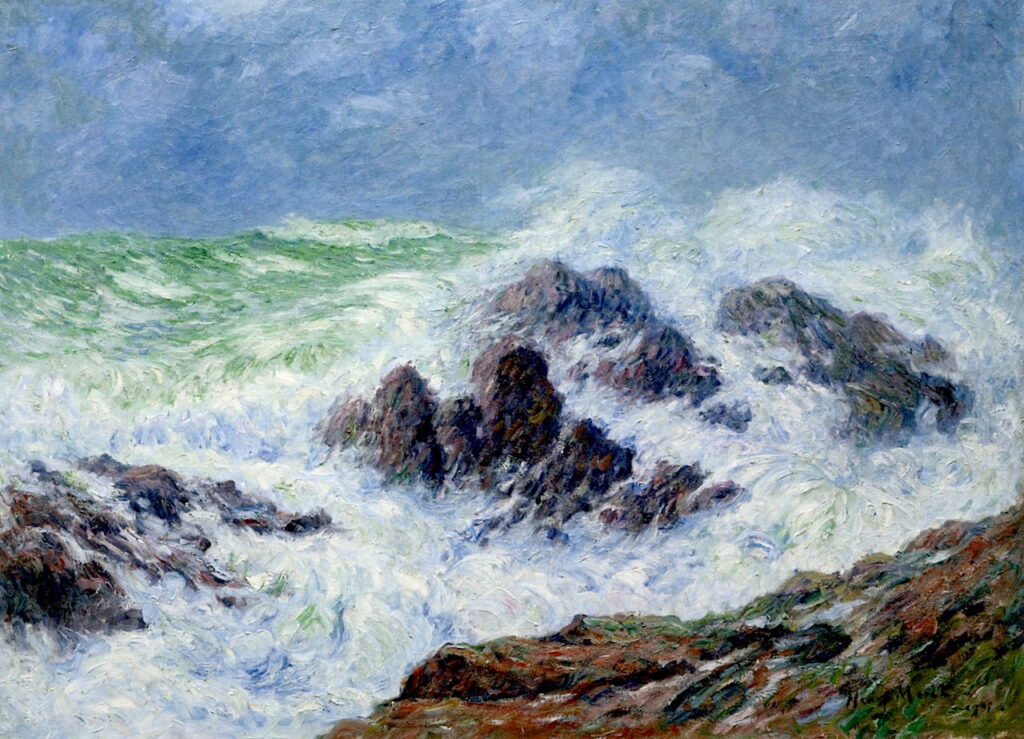End of the Earth: paintings of the far west of Brittany 2

In the first of these two articles looking at a selection of paintings of the extreme west of the Brittany peninsula in France, I had just reached the work of the Nabi painter and sculptor Georges Lacombe.
Georges Lacombe (1868–1916), Three Breton Women (Bigoudènes) in the Forest (1894), egg tempera, dimensions not known, Musée des Beaux-Arts de Quimper / Kemper, mirdi an Arzoù-Kaer, Quimper, France. Wikimedia Commons.
Lacombe’s Three Breton Women in the Forest from 1894 further identifies the women as being Bigoudènes, who wear their distinctive headdress in the Bigouden country in Brittany. For this painting he returned to the ancient medium of egg tempera, which enjoyed a revival among the Nabis.
Maximilien Luce (1858–1941), Camaret, Moonlight and Fishing Boats (1894), oil on canvas, dimensions not known, Saint Louis Art Museum, St. Louis, MO. Wikimedia Commons.
That same year, Maximilien Luce painted this outstanding nocturne of Camaret, Moonlight and Fishing Boats (1894). Camaret-sur-mer is a small fishing port in the far west of Brittany. The tower silhouetted in the distance is the Tour Vauban, a fortification dating back to the end of the seventeenth century, and now a World Heritage Site.
Georges Lacombe (1868–1916), Vorhor, The Green Wave (1896), egg tempera on canvas, 100 x 72 cm, Indianapolis Museum of Art, Indianapolis, IN. Image by Zambonia, via Wikimedia Commons.
In the last few years of the nineteenth century, Lacombe moved on from his early style influenced by Gauguin and the Nabis, and came under the influence of Japonisme. His egg tempera painting of Vorhor, The Green Wave from 1896 shows an Atlantic swell coming into the seacliffs of Vorhor near Camaret-sur-Mer. There are shades of Hokusai in his waves.
Georges Lacombe (1868–1916), The Violet Wave (1896-97), oil on canvas, 62.5 x 47.5 cm, Private collection. Wikimedia Commons.
The Violet Wave from 1896-97 is another painting by Lacombe that draws on the same sources.
J Lavée (dates not known), Ouessant, Seaweed Burners in 1898 (c 1898), illustration in ‘Ouessant, Enez Heussa, l’île de l’Epouvante’ by Paul Gruyer, 1898, further details not known. Wikimedia Commons.
This engraving of Ouessant, Seaweed Burners in 1898 (c 1898), probably by J Lavée, shows the island of Ouessant (Ushant), and illustrates a book on the island by Paul Gruyer.
The most prolific of the artists who painted in Finistère was Henry Moret, who was born in Cherbourg, and first seems to have visited Brittany during his military service. He came back later, to paint alongside Paul Gauguin and others in the artists’ colonies at Pont Aven and le Pouldu, further to the south-east.
Henry Moret (1856–1913), The Port of Audierne (c 1900), oil on canvas, 38 x 55 cm, Private collection. Wikimedia Commons.
Moret’s painting of The Port of Audierne from about 1900 shows this small harbour in the far west, beyond Quimper. Much of this canvas is covered by vigorous marks of concentrated colour.
Henry Moret (1856–1913), Cliffs at Ouessant (1902), oil on canvas, 46 x 61 cm, location not known. Wikimedia Commons.
Moret’s Cliffs at Ouessant (1902) shows Ouessant, the small and rugged island off the western tip of the peninsula. With a population of less than a thousand, its major industry at that time was fishing, and the seaweed was used as a fertiliser to support its limited subsistence farming.
Henry Moret (1856–1913), Heavy Weather at Saint Grenoble, Point de Penmarc’h (1905), oil on canvas, 73.7 x 100.6 cm, Private collection. The Athenaeum.
Moret’s Heavy Weather at Saint Grenoble, Point de Penmarc’h (1905) shows enormous seas breaking at this point to the south-west of Quimper, close to the northern end of the Bay of Biscay.
Artists came to the end of the earth not just to paint its spectacular scenery, but also its people. Jules Breton painted many locals, but these two works by Elizabeth Nourse are perhaps closer to reality.
Elizabeth Nourse (1859–1938), Return from Church, Penmarc’h (1900), media and dimensions not known, Cincinnati Art Museum, Cincinnati, OH. Image by Sailko, via Wikimedia Commons.
Around the turn of the century, Nourse painted this mother and her son as they made the Return from Church, Penmarc’h in 1900.
Elizabeth Nourse (1859–1938), Brother and Sister, Penmarc’h (c 1901), oil on canvas, 61.6 x 48.2 cm, Smithsonian American Art Museum, Washington, DC. Wikimedia Commons.
This double portrait of Brother and Sister, Penmarc’h (c 1901) is more sketchy, but looks to be in an almost identical location.



